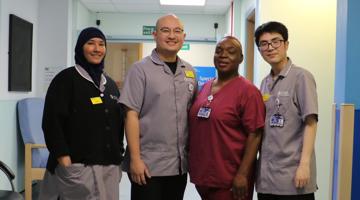-

Moorfields announces new new chief nurse
9 December 2025
-

Single Point of Access service changes name to Sparc
4 November 2025
-

Moorfields announces permanent chief executive
27 October 2025
-

Pioneering eye device restores reading vision to blind eyes
20 October 2025
-

Moorfields rated highest nationally in first NHS
9 September 2025
Read more news articles
Most read stories of 2025
Moorfields announces new chief nurse: Simmi Naidu - 3 December 2025
Single Point of Access service changes name to Sparc - 4 November 2025
Moorfields announces permanent chief executive - 27 October 2025
Pioneering eye device restores reading vision to blind eyes - 20 October 2025
Moorfields rated highest nationally in first NHS - 9 September 2025
National dementia guidelines updated thanks to Moorfields-led initiative - 1 September 2025
Moorfields use AI to detect keratoconus and atrial fibrillation - 21 August 2025
Oriel creative programme – have your say - 7 August 2025
Sheila Adam, chief nurse and director of allied professionals, celebrates 50 years of service - 24 July 2025
New adnexal service starts in Stratford- 23 July 2025
Diagnostic hubs could lead to more timely NHS care - 21 July 2025
Study flags evidence gaps in AI eye imaging devices approved for patient care - 16 June 2025
Patients “didn’t realise they had choice in receiving care”, finds new report on patient choice in elective eye care - 12 June 2025
Digital cataract service is quicker and better for patients - 10 June 2025
Moorfields consultant explains why your eyelids twitch - 9 June 2025
Important leadership update - 3 June 2025
New company launched to advance AI-driven eyecare - 6 May 2025
New genomic test saves Moorfields patient’s sight - 30 April 2025
Moorfields surgeons save the sight of 24 wounded Bangladeshi students - 15 April 2025
Announcing Professor Tim Briggs CBE as Moorfields' interim chair - 10 April 2025
10 Moorfields staff honoured on The Ophthalmologist Power List 2025 - 10 April 2025
Gene therapy – how Michel Michaelides came to meet Jace - 5 March 2025
Novel retinal pigment metric tackles bias in AI models - 4 March 2025
Important board announcement - 4 March 2025
Raising awareness of rare diseases - 4 March 2025
Important message from Moorfields Eye Hospital NHS Foundation Trust - 27 February 2025
Genetic therapy gives infants life - changing improvements in sight - 20 February 2025
Most read stories of 2024
Moorfields eye surgeon gives patient back her ‘voice’ - 20 December 2024
New centre reaches the top - 11 December 2024
Patients rate Moorfields A&E the best in the country - 5 December 2024
Single Point of Access (SPoA) wins prestigious HSJ award for innovation - 22 November 2024
Flossie Donovan is Starlight’s Mentor of the Year - 16 October 2024
Stallard – Olympian and ophthalmologist - 30 July 2024
Biomarkers reveal how glaucoma may respond 15 July 2024
Moorfields earns UK’s first UKAS accreditation for ophthalmic and vision science 5 July 2024
Roxanne Crosby-Nwaobi awarded RCN Fellowship 7 June 2024
Moorfields Eye Hospital granted royal patronage by King Charles - 21 May 20224
Read Moorfields Magazine Spring 2024 - 17 May 2024
11 Moorfields staff named on The Ophthalmologist Power List 2024 - 1 May 2024
Consultant awarded Bengal British Icons award - 29 April 2024
Moorfields governor election results - 23 April 2024
Innovations in glaucoma laser treatment - 14 March 2024
World glaucoma week 2024 - 12 March 2024
Rare Disease Day 2024 - 29 February 2024
Moorfields at Brent Cross reopens at new site - 28 February 2024
Dr Roxanne Crosby-Nwaobi awarded for achievements in eye and vision advocacy - 13 February 2024
Most read stories of 2023
Specific batches of carbomer containing lubricating eye gels recalled - 24 November 2023
New retinal detachment clinical trial - 8 November 2023
Moorfields signs the Armed Forces Covenant - 6 November 2023
Eye Envoys awarded coveted Nursing Times award - 31 October
Moorfields at Stratford opens new operating theatres for eye surgery - 31 October 2023
Effective treatment for rare sight-threatening infection - 30 October 2023
Moorfields welcomes Prime Minister Rishi Sunak to discuss AI research and safety - 26 October 2023
Moorfields to manufacture new contact lenses to reduce patient waiting times - 17 October 2023
World Sight Day 2023 - 12 October 2023
Sight-restoring therapy featured on BBC's The One Show - 11 October 2023
Moorfields nurse picks up prizes for research and innovation - 10 October 2023
Ophthalmologist Power List Rising Star - 9 October 2023
Moorfields’ Stars 2023: the winners - 28 September 2023
Landmark review of glaucoma treatment and research published by Moorfields-led team - 22 September
National Eye Health Week -18 September
Moorfields launch AI model to boost global research into reducing blindness -13 September 2023
Service move from Bedford North to Bedford South - 7 September 2023
Eye scans detect signs of Parkinson’s disease up to seven years before diagnosis - 21 August 2023
Moorfields hosts new direct referral pathway from optometrists across North Central London - 7 July 2023
Moorfields represented at Westminster Abbey for NHS75 - 6 July 2023
Statement on recent tribunal outcome - 9 June 2023
Windows of the Soul exhibition opens at City Road - 24 May 2023
Moorfields celebrates International Clinical Trials Day - 19 May 2023
Emily and Robin elected as Moorfields governors - 17 May 2023
Moorfields achieves nursing Pathway to Excellence - 12 May 2023
